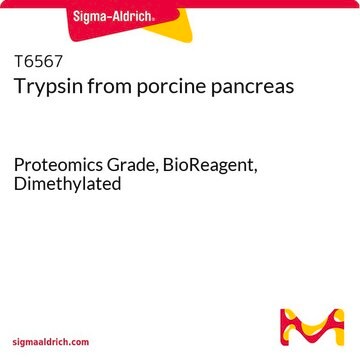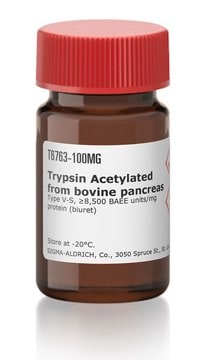This product is not sterile and will need to be sterile filtered. See product SLGP33RS, Millex GP, for a suitable filter options:
https://www.sigmaaldrich.com/product/mm/slgpr33rs
T1426
Trypsin from bovine pancreas
TPCK Treated, essentially salt-free, lyophilized powder, ≥10,000 BAEE units/mg protein
Synonym(s):
Serine Protease 1
Select a Size
Select a Size
About This Item
Recommended Products
biological source
bovine pancreas
Quality Level
grade
Proteomics Grade
form
essentially salt-free, lyophilized powder
specific activity
≥10,000 BAEE units/mg protein
mol wt
23.8 kDa
solubility
hydrochloric acid: soluble 1 mM
application(s)
diagnostic assay manufacturing
foreign activity
Chymotrypsin ≤0.1 BTEE units/mg protein
storage temp.
−20°C
Looking for similar products? Visit Product Comparison Guide
Application
Biochem/physiol Actions
Serine protease inhibitors, including DFP, TLCK, APMSF, AEBSEF, and aprotinin, amongst others, will inhibit Trypsin.
Components
Caution
Unit Definition
Preparation Note
It is also TPCK-treated and dialyzed. Treatment with L-1-Tosylamide-2-phenylethyl chloromethyl ketone (TPCK) reduces the chymotrypsin activity which is usually present in trypsin.
inhibitor
substrate
Signal Word
Danger
Hazard Statements
Precautionary Statements
Hazard Classifications
Eye Irrit. 2 - Resp. Sens. 1 - Skin Irrit. 2 - STOT SE 3
Target Organs
Respiratory system
Storage Class Code
11 - Combustible Solids
WGK
WGK 1
Personal Protective Equipment
Choose from one of the most recent versions:
Certificates of Analysis (COA)
Don't see the Right Version?
If you require a particular version, you can look up a specific certificate by the Lot or Batch number.
Already Own This Product?
Find documentation for the products that you have recently purchased in the Document Library.
Customers Also Viewed
Protocols
Continuous spectrophotometric rate determination method using BAEE substrate measures trypsin activity, essential for enzyme characterization.
-
I would like to ask, is the Trypsin, TPCK-treated already sterile when I solve the powder in sterile aquadest, or have I to filter the solution?
1 answer-
Helpful?
-
-
Does Product T1426, Trypsin from bovine pancreas, work for in-gel digestions?
1 answer-
For in-gel digestions, we actually recommend using a methylated trypsin. Product No. T6567 is Trypsin from porcine pancreas, proteomics grade, dimethylated. For product T6567, the lysine residues of proteomics grade trypsin have been reductively methylated, resulting in a product that is resistant to autolysis. The T6567 has also been treated with TPCK to remove chymotryptic activity, further purified through affinity chromatography, and lyophilized. This results in an enzyme that gives highly specific cleavage.
Helpful?
-
-
What is Product T1426, Trypsin from bovine pancreas, soluble in, and how do you recommend storing solutions?
1 answer-
Trypsin is soluble in 1 mM hydrochloric acid (pH approximately 3). It is also surprisingly stable in 1 mM HCl. Solutions are stable for approximately 1 year when aliquoted and stored at -20°C. The presence of Ca2+ (20 mM) will also retard trypsin's ability to autodigest, and will therefore help to maintain the stability of the trypsin in solution.
Helpful?
-
-
How much of Product T1426, Trypsin from bovine pancreas, should I use to digest my peptide?
1 answer-
For trypsin digestion of peptides, use a ratio (w:w) of about 1:100 to 1:20 for trypsin:peptide. Trypsin preparations usually contain some contaminating chymotrypsin and this should be inhibited with N-tosyl-L-phenylalanyl chloromethyl ketone (TPCK). Product No. T1426 has already been treated with TPCK, so it does not need to be further treated.
Helpful?
-
-
What is the Department of Transportation shipping information for this product?
1 answer-
Transportation information can be found in Section 14 of the product's (M)SDS.To access the shipping information for this material, use the link on the product detail page for the product.
Helpful?
-
-
What is the extinction coefficient for Product T1426, Trypsin from bovine pancreas?
1 answer-
Various values have been reported in the literature for the extinction coefficient of bovine pancreatic trypsin. The E1%(280) values have ranged from 12.9 - 15.4. When we assay the protein content of Product No. T1426 in our labs here at Sigma, we use a value of 14.4.
Helpful?
-
Active Filters
Our team of scientists has experience in all areas of research including Life Science, Material Science, Chemical Synthesis, Chromatography, Analytical and many others.
Contact Technical Service










